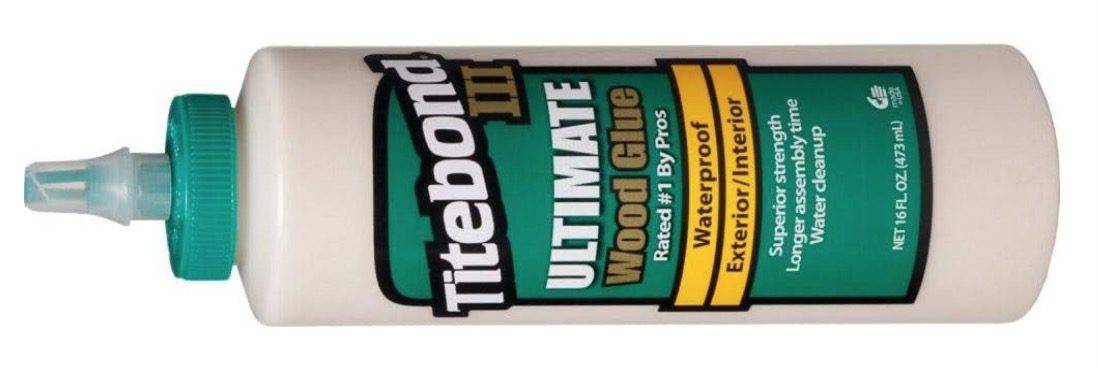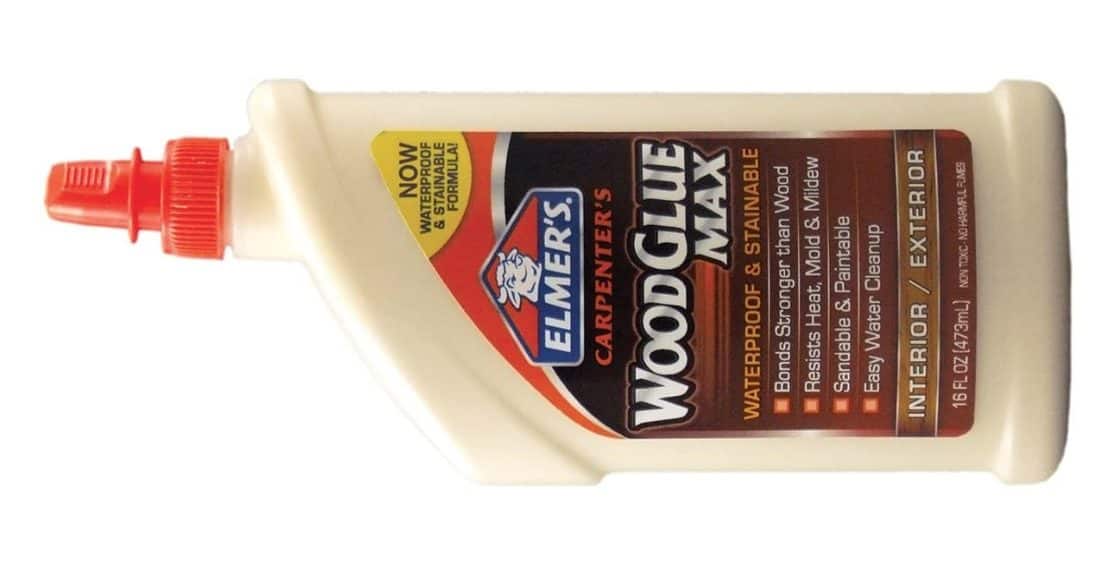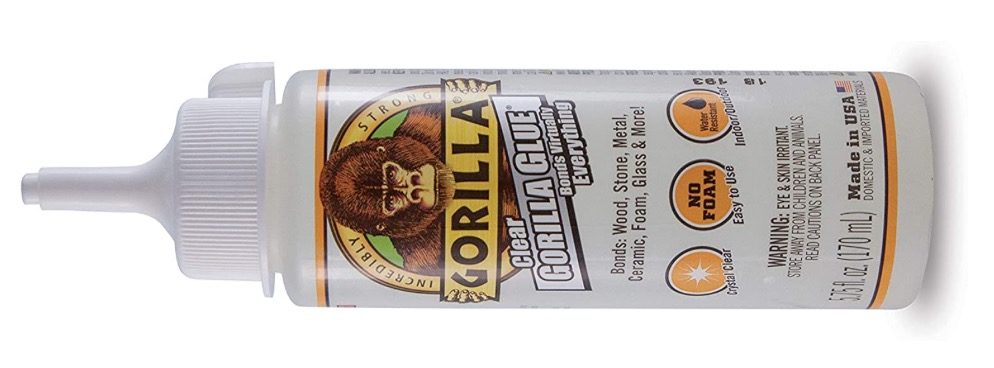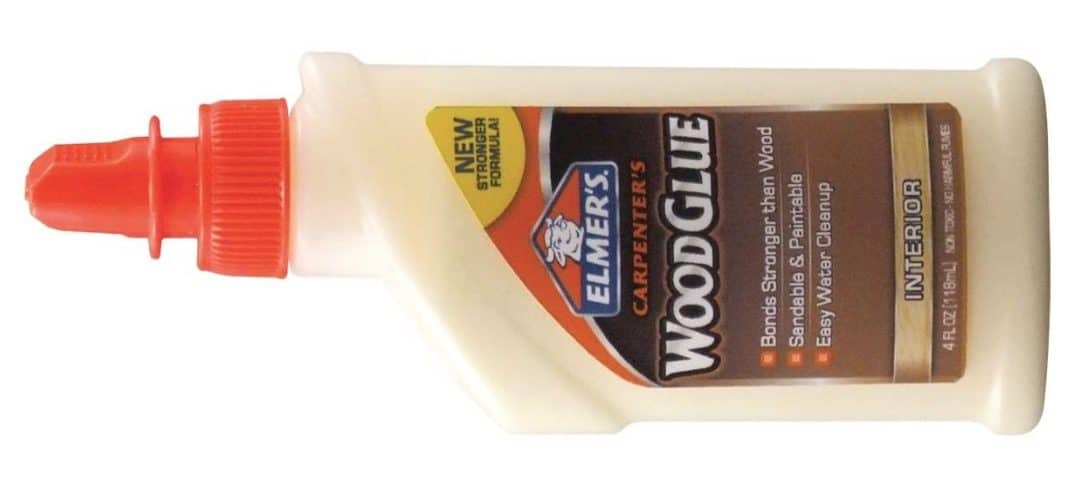Buying wood glue is not as simple as it seems. Even the most basic hardware store has many glue options with different strengths and weaknesses. And then just when you think you figured things out you will see “premier” and “ultra” glue varieties… what does that even mean?
Here are the best wood glues for your home projects. But keep in mind that wood glues tend to have true fans, so you might find someone that always buys Titebond, or swears by Gorilla. That’s fine, and those are good brands so they likely aren’t far off, but here’s what we think.
The Short Answer
If you want a great wood glue you can get Titebond III or Elmer’s Max for any job. If you want to save some money Titebond II works great too. If you are only working indoors, you can get Titebond I or Elmer’s carpenter’s glue.
If your work might touch food — say if you are working on a cutting board or countertop — then make sure you use Titebond II or Titebond III.
A Note On Pricing
Glues and other liquids can cost more online, especially if you buy smaller sizes. Once you get to larger sizes — usually at the gallon size — you can actually save money by buying online.
Case in point: I recently bought some wood glue. I went with Elmer’s Carpenters Glue as it was a low-demand job and the small bottle I bought (to use as the applicator) cost me $6 and the gallon I also purchased (to refill the small one) cost me $22. Online that same purchase would have cost $9 for the small one and $19 for the gallon. I needed the glue that day so the in-person buy made sense. The lesson? Plan ahead to save.
This was for indoor work, specifically garage repairs, so Elmer’s Max was not necessary.

Titebond III Ultimate Wood Glue
Titebond Ultimate wood glue — known as Titebond III — is available with some very competitive features. It is suitable for small project work but you probably won’t want it for large jobs and definitely not for wainscoting (etc.) as it costs almost a dollar per ounce in smaller sizes. As with all wood glues, you can save a lot by buying in bulk.
- Titebond Ultimate Gallon: 128 fluid oz., $29.00 or 23 cents per oz.
- Titebond Ultimate 16oz: $8.50, or 53 cents per oz.
Why is it “Ultimate” though? This has to do with the bond strength as well as other advantages, like how this glue is more waterproof than other wood glues and can be applied at lower temperatures, so it’ll be good for those cold nights in your unheated garage (you’re going to get that oil heater this year right?). Titebond II (“Premium”) has more strength than the original and also works outdoors, where Titebond I (“Original”) is only for indoor use.
Titebond Ultimate doesn’t discolor the wood surface after using it. It also doesn’t leave any chemical smell.
Key Features
- It resists moist conditions and water
- Proprietary polymer glue formula
- Quick drying time
- It can be applied to indoor and outdoor wood surfaces
- It is FDA-approved as safe for indirect food contact (for example butcher’s block)
- Can be sanded
- Non-toxic, solvent-free
Titebond II vs Titebond III
A lot of people like Titebond II, and it’s a very good glue, but they have trouble figuring out the difference between Titebond II and III. Here’s what you need to know:
Titebond III:
- has a higher strength bond than
- will resist drying out longer if the glue is exposed to the air (while you are adjusting parts)
- works down to 47 degrees F (instead of II’s 55 degrees)
- dries light brown (instead of orange)
What about Titebond III vs Titebond I? TBI is lower strength, doesn’t work in cold temperatures, and is designed to work indoors only!

Elmer’s Carpenter’s Wood Glue Max
Elmer’s Wood Glue Max is the most popular option for all kinds of carpenter’s job, and it is also suitable for all types of wooden surfaces. This glue makes the bond firmly and has very good strength (but it’s not best-of-class).
One important thing to know about Elmer’s Max glues is that it’s not only useful for wood, but works on other substances and surfaces. You don’t get the versatility of something like Gorilla Glue Clear but it’s still a great glue to have around..
Key Features
- Non-toxic, fume-free
- Indoor or outdoor use (unlike standard Elmer’s wood glue)
- Heat-resistant
- Mildew-resistant
- Water-resistant formula
- Holds up to paint and stain
- Quick-drying (30 minutes of clamping and 24-hours for full bond)

Gorilla Clear Glue
Gorilla Clear Glue leaves surfaces clean and visible after using it. It is one of the best options for bonding all kinds of work past wood, including ceramic, stone, tile, and even foam.
Gorilla Glue is generally known for its strength, but this one is clear too instead of the normal tan. Like normal Gorilla Glue, clear doesn’t emit gross (or toxic) fumes.
Key Features
- Polyurethane glue formula
- Works with many different surfaces
- Dries and applies clear
- Super strong, non-foaming formula
- Slower than normal drying (2 hour clamp time)

Gorilla Wood Glue
This list wouldn’t be complete without Gorilla Glue in one form or another, but we have two.
Gorilla Wood Glue has a cross-linking bond, which is ideal for different types of wood. It can get entirely cured within a short period. It is famous for being a high-performance adhesive (and of course the gorilla). It is a perfect option for outdoor work due to its waterproof design — something that’s a special feature on some competing glues (see Elmer’s).
Key Features
- It is water-based glue, including a strong bond
- It dries completely within less than 24 hours
- Wide-horizontal applicable on smaller bottles (under 1 gallon)
- It is water-resistant and suitable for outdoor and indoor work
- It is a suitable option for softwood, hardwood, and wood composites
- Doesn’t wash off very well

Budget Pick: Elmer’s Carpenter’s Wood Glue
Like everyone else we like Elmer’s Carpenters Wood Glue as it’s affordable, reliable, and easy to find. It share most features with the Max variants, but has these key differences…
- Indoor-use only
- Not water-resistant
- Easier clean-up
- Cheaper than Wood Glue Max
Other Wood Glues
There are other wood glues on the market, but we don’t have enough knowledge about them to recommend them. Some of these are really appealing sounding, like Evo-Stik exterior glue, which sounds great thanks to 10 minute drying times, weather-proof formula, and being sand-able when dry.
There are also specialty wood glues, like JB Wood Bond, which is actually an epoxy, not a conventional glue. This stuff is really good for repairs, like a broken lamp or piece of moulding, but isn’t something you’d use like a conventional wood glue.
FAQs
What’s the difference between Elmer’s Carpenter’s Wood Glue Max and normal Elmer’s Carpenter’s Wood Glue?
The main difference between these two, aside from the price, is that the Max version is accept for use on outdoor job and it is waterproof. Normal Elmer’s Carpenters Wood Glue is designed for indoor use away from water and extreme temperature shifts.
Does wood glue only work with wood?
It depends on the wood glue. Almost all basic wood glues, like Elmer’s Carpenters glue, are designed to only work with wood. Others, like Gorilla’s wood glue are designed to work with glue, but actually are OK on some other surfaces. And then you have Gorilla Glue Clear, which is a multi-purpose glue that works on wood. Generally speaking wood glue works best on wood but I can be used in other applications.
What’s the difference between Titebond II and Titebond III?
These two glues are very similar but they do have a different formula which gives Titebond III a higher bond strength and the ability to set at lower temperatures (down to 47 degrees F). Titebond III is typically a little more expensive and it dries to a brown instead of an orange shade. Other than that the two wood glues are quite similar. Both are FDA-approved for indirect food contact but only Titebond II works with radio-frequency gluing systems.
What’s the difference between Titebond I and Titebond II?
Titebond I Original is a different formula from Titebond II Premium. Titebond I is an indoor-only wood glue with a bond strength of 3600 psi where Titebond II will work outdoors (it’s weatherproof) with a bond strength of 3750 psi. Importantly, Titebond I dries to a dark yellow color (like pine) where Titebond II dries to more of an orange tone. For niche scenarios it might be important to note that Titebond II can instant-bond radio-frequency gluing and that it’s FDA-approved for indirect food contact surfaces. Titebond III doesn’t work with RF systems.
What is wood glue?
Wood glue is a kind of adhesive that is used to join pieces of wood together. You can use wood glue for carpentry work, gluing light boards to a wall, or just fixing furniture. Simply put, it’s a general use adhesive that is designed to be used with wood.
What good glue is the most popular?
The most popular wood glues in most stores are Elmer’s Carpenters Wood Glue, Gorilla Glue, and Titebond. Many people don’t even know that other wood glues exist, but they sure do. There are also many variants on these glues, like Elmer’s Carpenters Wood Glue Max, which have come up in recent years. These more expensive glues are tempting, but their value is sometimes questionable.

